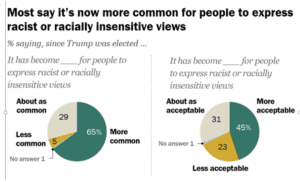Racism in American Society
According to W.E.B. Du Bois (1903), “The problem of the Twentieth Century is the problem of the color line” (Du Bois, p.18). This statement suggests that racism is engraved in society because of the differences in people’s color. Although Du Boi’s statement portrays the reality in most communities, I think the issue of racism extends beyond color. In my opinion, racism is a problem of people’s attitudes and beliefs that have been passed from one generation to another about people of a specific color. Ignoring these attitudes has led to the prevalence of racism in the United States. According to BBC (2020), it is easy for white people in America to classify the past, thus viewing past injustices as being irrelevant, but African Americans do not consider the injustices in the same way. African Americans’ view of racial injustices is mainly influenced by the discrimination they experience in society. In addition, a report prepared by Pew Research in 2019 indicated that it is common for people in American society to express racism (Horowitz et al., 2021). The results of the Pew research are illustrated in Figure 1 below.
Figure 1: Expression of racism in American societies (Source: Pew Research Center, 2019)
The attitudes and beliefs passed from generation to generation about people of a specific color in the United States have been nurtured by increased inequality and discrimination in the American education system, housing, and employment. African Americans have been left out of the housing programs in the United States since the redlining era, which created limitations for African Americans to buy houses because they could not access mortgages (Robertson et al., 2022). During the slavery period, African Americans were also prohibited from owning property, including homes, so that they could continue working for the whites as enslaved people. Such practices created negative attitudes and beliefs about African Americans, leading to the prevalence of racist practices that have since then been passed from one generation to another up to now. The discrimination of African Americans in the education system has also been a practice passed from one generation to another. For example, schools dominated by African Americans and other minority groups receive fewer funds compared to white-dominated schools, thus making it hard for them to offer quality education. Hire our assignment writing services in case your assignment is devastating you.
The inequality in the quality of education has expanded the achievement gap between whites, African Americans, and other minority groups because the minority groups and African Americans have lower standardized costs compared to whites. Racist attitudes and beliefs also lay a foundation for racial discrimination in the employment sector. African Americans and other minority groups face high unemployment because of discrimination by employers and colleagues. In some instances, African Americans and minority groups are discriminated against because of their color despite being qualified for a job. Sometimes, African Americans may quit their jobs due to discrimination, leading to high unemployment. Discrimination in the employment sector is also evident in the pay gap between whites and African Americans in various workplaces. African Americans mostly earn less than whites doing the same job, leading to an increase in the wealth gap.
In conclusion, addressing racism in American society requires eliminating racist beliefs and attitudes that are evident because of how people perceive one another based on color. Eliminating these beliefs will break the cycle of discriminating against minority groups and African Americans in employment, housing, and education since these are the main areas where racism is portrayed, making it hard for people to abandon racist views about people of a specific color.
References
BBC. (2020, October 30). US election 2020: Why racism is still a problem for the world’s most powerful country. BBC News. https://www.bbc.com/news/election-us-2020-54738922
Du Bois, W. (1903). The souls of black folk.
Horowitz, J. M., Brown, A., & Cox, K. (2021, September 22). Race in America 2019. Pew Research Center’s Social & Demographic Trends Project. https://www.pewresearch.org/social-trends/2019/04/09/race-in-america-2019/
Pew Research Center. (2019, April 9). Race in America 2019. Pew Research Center’s Social & Demographic Trends Project. Retrieved April 5, 2023, from https://www.pewresearch.org/social-trends/2019/04/09/race-in-america-2019/.
Robertson, C., Parker, E., & Tach, L. (2022). Historical Redlining and contemporary federal place-based policy: A case of compensatory or compounding neighborhood inequality? Housing Policy Debate, 1-24. https://doi.org/10.1080/10511482.2022.2026994.
ORDER A PLAGIARISM-FREE PAPER HERE
We’ll write everything from scratch
Question
Week One Course Blog Project
Throughout this course, you will read scholarly work on questions of diversity, exclusion, and inclusion. You will write a weekly blog reflecting upon those issues, but rather than offering an unsubstantiated opinion on these matters, you’ll be expected to offer a unique but informed opinion supported by scholarly research and empirical evidence.

Racism in American Society
You will have the freedom to choose the topic and the particular angle of the issue as you wish to explore it, but there are some clear parameters you’ll need to follow.
Each blog entry must have the following:
Minimum 500 words (15% penalty for falling short of the word count)
1 citation from academic source materials read that week in class. This must be cited with a page number and author. Sources may not be reused week-to-week. (Academic source material attached)
1 citation of an academic source (a relevant peer-reviewed article) from outside of class. Hint: Wikipedia is not an academic source. Sources may not be reused week-to-week.
1 citation of a news media article relevant to the topic.
At least one audio or visual element that adds substantial content to support your argument. This could be a link to a video, pictures, etc.


